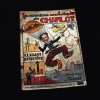2014 marks the launch of the SONAE / MNAC Art Cycles, a series of exhibitions that constitute the first major public event to be held under Sonae’s patronage of the Museu Nacional de Arte Contemporânea – Museu do Chiado (MNAC – MC). This initiative stems from the idea of inviting an artist from Portugal or abroad every two years to put on a high-profile solo exhibition within the Portuguese art scene. The visual artist Daniel Blaufuks has been invited to create the first in this series of exhibitions.
The exhibition that Daniel Blaufuks is presenting at the MNAC – MC, All the Memory of the World, Part One, is closely linked to the PhD project that he is carrying out at the University of Wales in Newport. It draws a connection between two key works by two cult European literary authors, in which fiction and individual memories of the Holocaust are deliberately mixed, through deceptions, crossovers and quotations that mislead the reader as to the direction that the narrative is taking, and in the exploration of memory that is triggered by that very process. The exhibition focuses on works made up of photographic images from sources that cover a broad technical and temporal range, and features parts of W ou le souvenir d’enfance (1975), by the French author Georges Perec, and German writer W.G. Sebald’s novel Austerlitz (2001). The latter work had already inspired Blaufuks during his first major research project on Terezín, a small fortified town in what is now the Czech Republic. Terezín was given the name Theresienstadt during the occupation by Nazi Germany during World War II, and was the only concentration camp to be visited by the International Red Cross, in 1944.
Taking this world as its starting point, the exhibition presents a vast array of works associated with the idea and actual creation of an “atlas of images” about memory – which assumedly draws inspiration from Aby Warburg’s “Iconology of the Interval” – creating a sort of visual map through which the artist seeks – in his own words – “to embark on a journey through different ways of looking, through variations on the same theme, collecting and selecting images of identical subjects, or similar key-words arranged in visual patterns.”
The images of Daniel Blaufuks seek to unite the spaces or gaps in perception by joining together rather than tearing apart, even though we ultimately come away with a sense of indecision, openness and speculation about them. The artist’s faith in the images, in spite of growing doubts about the actual power of photography in this process, holds him captive to an imperative exercise which necessitates an absolute compromise when using his powers of production and reflection, indicating that the memory mirrored in the immanence of photography is a kind of shadow that haunts us constantly, in every movement of bodies and light.








